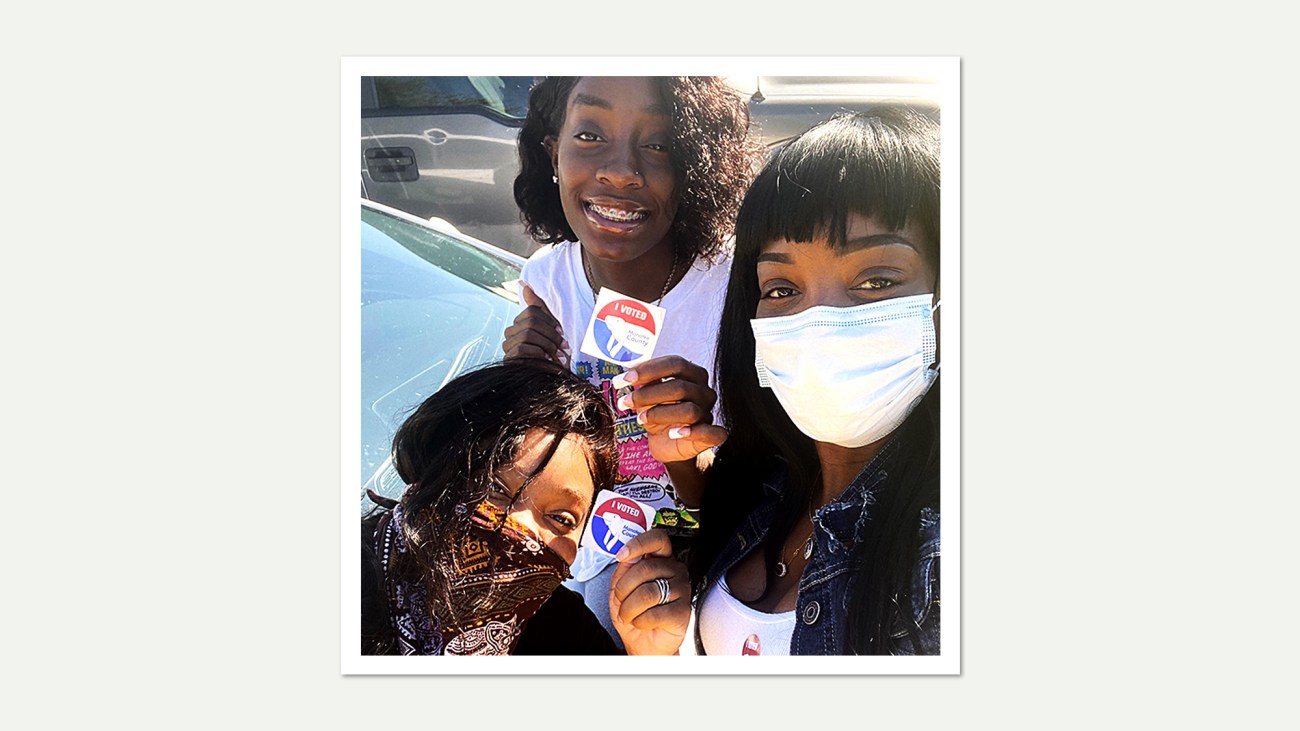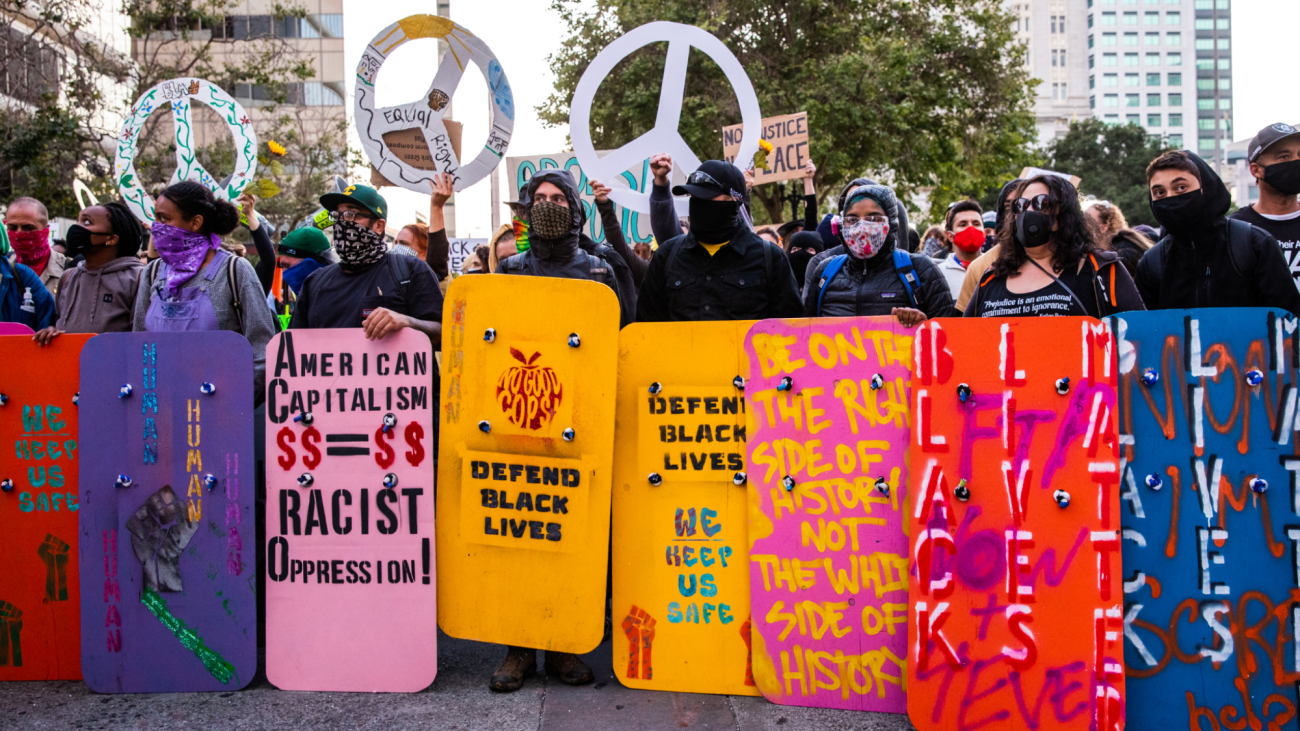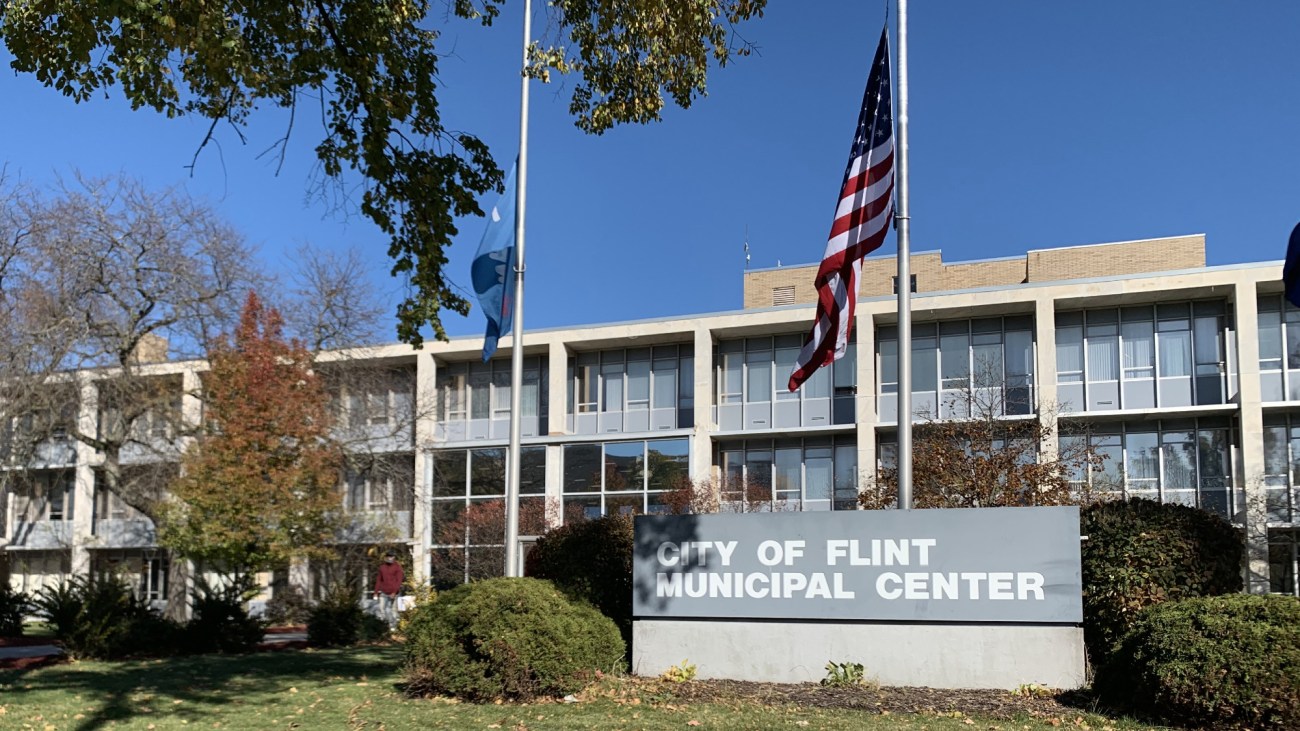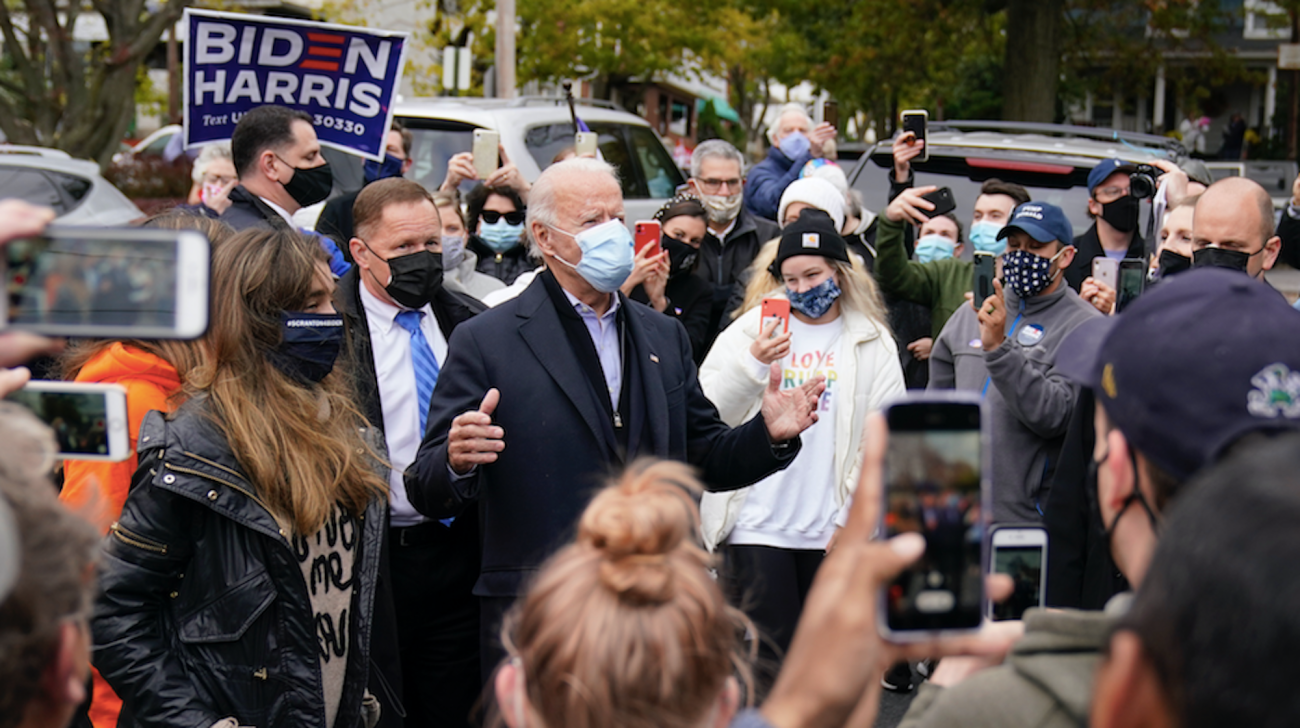 |
| LaToya Moreland, 39, right, takes a photo with her daughters after voting in Bradenton, FloridaCourtesy of LaToya Moreland |
A Sense of Doubt blog post #2088 - Fighting the New Jim Crow Thanks to Donations and other news
-2 DAYS: Daily Election Day Countdown
We're still counting as a nation the votes from the pandemic election.
I shared The New Jim Crow book in class Tuesday and then subscribed to Mother Jones linked here.
Kudos to LeBron "More than a Vote" James and Michael Jordan for donating money to help people like LaToya Moreland to be eligible for vote by wiping out the debt from her court costs for incarcerating her.
BTW, it's total BULL SHIT that ex-cons need to be responsible for the court costs for being incarcerated.
Really?
That's a fair debt to saddle someone with for life and then WITHHOLD their right to vote until they clear the debt that they cannot pay?
Grotesque.
But now thanks to James, Jordan, and others Moreland and many others were able to vote for the first time in years or ever.
Just think how this election would have gone if all the American citizens who are incarcerated were allowed to vote?
I Just Voted in My First Election Since My Felony Conviction. I’m in Tears.
A Florida mom recounts her rocky journey to the polls today.
BY LATOYA MORELAND AS TOLD TO SAMANTHA MICHAELS
LaToya Moreland’s attempt to vote for the first time in 12 years was an emotional roller-coaster. The 39-year-old mother of four is a lifelong Florida resident, but she’d been prohibited from casting a ballot because of her felony record. Then, in 2018, citizens in her state approved Amendment 4, a measure that activists hoped would restore voting rights to more than 1 million people with felony convictions.
The triumph was short-lived. The next year, Florida lawmakers passed a law stipulating that people with felony records could only vote if they’d paid off all the fines and fees associated with their convictions—and Moreland simply couldn’t afford what she owed. So she and a small group of other Floridians sued, arguing that the new rule was similar to an unconstitutional poll tax. In September an appeals court narrowly ruled against them. Florida Secretary of State Laurel Lee assured voters with felony records that they would not be removed from the rolls before the election, since more time would be needed to fairly handle that process. But she said anyone who knew they had lingering fines and fees should abstain from casting a ballot. That included Moreland.
But, after sympathetic celebrities donated to help Moreland tackle her debt, she made it to the polls today in Bradenton, Florida, with two of her daughters in tow. It could be a close election there; her county narrowly favored Donald Trump four years ago. I caught up with her after she cast her ballot, as she held back tears of joy. Here’s her story, in her own words.
I’m not gonna even lie. When I woke up this morning, I was sick. I don’t know if it was the nervousness of being able to go vote. But I woke up with my stomach all nauseous.
My daughters and I went around 8:30 or 9 this morning. We drove to the local church, and along the way there were a lot of signs everywhere, for everybody, but more Biden signs down this way. I wanted to vote in person because I haven’t had my right—I was so excited to exercise my right to vote. And I’ve been following everything so close: A lot of stuff is going on with the mail-in ballots. And I just did not want to take that chance.
Oh, I was nervous. Because when I got there, that guy took so long looking at my ID; he was saying I looked different. By the time he was finished, my daughters had voted already. But other than that, everything went smooth. They had people in different areas of the church for people who needed help. And they had the sample ballot in case you weren’t aware who was on it. After I finished, I took a picture with my daughters and posted it on Facebook. I was so excited; words can’t really express it.
This wasn’t my first time voting. I’m 39 and have lived in Florida my entire life, and I was able to vote in 2008. But I’ve had my felony since 2011, for possession of a controlled substance, and it prevented me after that. So when Amendment 4 passed, I registered immediately. It was important to me because, being an African American, we go through so much. Because our voice was nothing. We couldn’t say stuff, or we couldn’t voice our concerns. Our ancestors and women around the world, before our time, fought to be able to vote. So it was really important for me to go out and say, “Listen, my voice may not mean much, but I’m gonna make sure somebody hears it, and I’m gonna make some noise until somebody does hear it.”
I had registered and they sent me the card and everything. And then [before the primary] I got a letter stating that I couldn’t vote. I was able to find out that I had fines and fees from my conviction—they said it was around $900 in total. If I’d had the money, I would have paid my fine. I just, I didn’t have it. I’m on a fixed income. And it’s really hard for a single mom of four, two being in college. I used to do hair, I’ve done cosmetology, but I’m disabled now. My income is so tight that I don’t even have spare money to go buy a soda, you know, after I pay my bills.
When they passed Amendment 4, everyone thought that if you were a convicted felon that you were going to be able to vote. We didn’t know there’d be stipulations. And it was very confusing.
[When the court ruled against us] I thought that we were over. I just knew we weren’t going to be able to vote unless we had the money to pay the fines. I don’t smoke, I don’t drink, so I just cried. I talked to my kids about it, and they said, “Something good is gonna happen. You’ll be okay.”
And as it turns out, somebody paid off my fines and fees. If I’m not mistaken, when the lady spoke to me she said LeBron James and Michael Jordan were paying some people’s fines, so I’m guessing they did. They paid everything. I found out recently in a phone call. I saved the voicemail. She was saying that this was so and so from the Florida voting rights organization, and they paid off my fines and fees. I was like, I can’t believe it. It’s really real.
The biggest race I was passionate about was the presidential election. I’ve been following this thing for so long and they both say good stuff. But then you’re acting like a kid on national TV, arguing back and forth. So that kind of made me wait to the last minute to say, “Okay, What should I do? Which way should I go?”
Along with the presidential, I paid attention to the amendments, and I studied those really hard to make sure I chose correctly. Especially for the one with family members in the military, making sure they are able to reap the benefits of their spouse if they were to pass away. That one really meant a lot to me because my dad fought in the Vietnam War.
Now that I’ve voted, I’m still nervous. Because where I live, it’s a lot of people saying, “Oh, if Trump wins, it’s gonna be a riot. If Biden wins, it’s gonna be a riot.” And I got kids, I can’t afford it. I just I don’t understand why there has to be a riot. I mean, it’s just crazy. I know I shouldn’t say this, but I did: I voted for Biden. I really feel like he’s gonna make sure me and my kids are gonna be okay in the end. And so I’m really praying that this works out.
To the Florida lawmakers who created these restrictions on voting, I would tell them I understand that the law is the law. And for us to have these fees, we have to have broken some type of law. But that’s not who we are. People make mistakes. People learn from mistakes. At least most people do. We’re not in control over a lot of stuff that happens. But it’s okay to give people a second chance, a chance to try to right their wrongs.
I’m wearing my voting sticker proud right now. (Laughs.) And I’m not gonna lie, as I sit here talking to you, to even be able to fathom that my experience means something to somebody else, or it can help somebody, I’m in tears, it means so much to me. And I am so happy that I was able to share the experience with my kids. To everyone that was put in place along the way to help me vote, I am so grateful for each and every one of them. And I just hope that everyone that has been given a second chance to let their voice be heard, I pray they do it and stand proud, because I am.
https://www.motherjones.com/2020-elections/2020/11/flint-robocalls/
Flint Voters Make Their Way to the Polls Despite Suppression Robocalls
“I’ve lived through several elections of presidents, but nothing like this.”
AJ VICENS
Early on Tuesday morning, Michigan Attorney General Dana Nessel tweeted about robocalls that seemed to be an attempt to suppress voting in Flint:
Voters at the City of Flint Municipal Center on Tuesday were undeterred and encountered no such lines, although some said they had heard about the texts before arriving. One, who declined to give his name, said he saw reports of the text messages “all over the place. I was expecting to wait two hours.”
Timothy Fenior, who was with the man, said that despite their fears, “actually they got us in and out fast. It was nice.”
“Just for our sake of being gay men, I hope that Joe Biden becomes president,” Fenior said. “I think people have to vote for our lives today, unfortunately.”
Nadie Holmes, another voter dropping off a completed ballot, said that like a lot of people around the country, she wants the election to be over. It has felt “for lack of a better explanation, like a big nightmare,” she said. “I’ve lived through several elections of presidents, but nothing like this.”
“There’s too much division and hatred and violence that’s going on,” the 30-year Flint resident said, adding that more people in her circles are voting this cycle than in the past. “They want to see a change.”
Jason Garcia and his son, also named Jason Garcia, were at the center to resolve an issue with the younger man’s registration so he could cast his first ever ballot.
“I voted,” said the younger Garcia, who is just 18. “It feels cool, I guess, my first time.”
As they exited the building, the father snapped a picture of his son. “Mom wanted a picture to record it to keep for memories,” he explained.
How Biden and Trump Spent Their Election Day Mornings Could Not Be More Different
Hint: one spent it whining about media coverage and sounding very defeated
In the final hours of the 2020 presidential race, the stark contrast between Donald Trump and Joe Biden has, once again, come into sharp focus.
This morning, Trump called into Fox & Friends nearly an hour late, using his appearance to blast the media and complain that his time in office has been “mean.” Though his words projected confidence—”we’re feeling very good,” he claimed—Trump sounded deflated and his hoarse voice hinted at exhaustion. In a surprising twist, Trump unleashed his harshest criticism on Fox News.
“In the old days, they wouldn’t put sleepy Joe Biden on every time he opened his mouth,” Trump said, whining about the network’s decision to air Biden rallies. He added, “It’s a much different operation, I’m just telling you.”
Meanwhile, in Delaware, Joe Biden attended morning mass and visited the gravesite of his late son, Beau Biden.
It’s a small thing, but the difference in how the candidates spent their respective mornings on the most important election in a generation could not be more pronounced. It tells you a whole lot about character—if that’s still something you’re inexplicably undecided about.Former Vice President Joe Biden went to a church service and visited his son Beau Biden's grave Tuesday morning in Greenville, Delaware. Biden will travel to Pennsylvania before returning to Delaware to watch election results https://t.co/BFuhLbrFNI pic.twitter.com/UQrCWhbLGn
— CBS News (@CBSNews) November 3, 2020
 |
| Protesters at a July demonstration in Oakland carry shields painted by the Oakland Builders Collective.Natasha Moustache/Getty |
These Activists Are Building Shields to Prepare for Whatever Comes Next
“We don’t want people getting hurt anymore.”
On this warm October afternoon, 30 people have gathered for a shield building party in West Oakland’s Lil Bobby Hutton Park. They kneel on a tarp splotched with spray-paint and glitter, stenciling slogans onto 2–by–4-foot plywood rectangles with rounded corners that have been buzz-sawed in batches of three. The shields are hefty, but are easily carried with one arm through the straps that are being attached to each one after it’s painted, along with a strip of foam to protect the forearm of someone carrying it for hours.
The shields are a project of the Oakland Builders Collective, a volunteer crew that has spent the past few months making 500 shields for protesters to use to protect themselves. So far, the collective has provided custom-made shields to more than 10 activist groups in 5 Bay Area cities. Even with the help of dozens of volunteers like those who have come out today, it is “already beyond capacity,” says F., one of the group’s founders, who requested that his name not be used out of concerns around doxxing.
Among the shield builders is a 29-year-old nonbinary farmer and medic I’ll call Sasha, who first used a shield at a racial justice protest this summer. One night in August, Sasha had arrived in downtown Oakland with a toolbelt loaded with granola bars, herbs to clean wounds, and a spray bottle filled with Maalox and water (a tear gas remedy). A hundred or so people had intended to march peacefully, but when someone smashed windows at a Whole Foods, police in riot gear moved in and declared the gathering an “unlawful assembly.”
Fear and confusion splintered the crowd, and someone handed Sasha a plywood shield. “I don’t even know what I’m gonna do with this,” they recall thinking. “There’s so many more cops than shields.” But as Sasha watched people run from the police, they could see how the marchers might have held their ground if they’d had more shields and better training—which is why they’re here making shields today.
As millions of Americans came out to protest peacefully after George Floyd’s killing in May, police in many cities responded with batons, pepper spray, tear gas, and projectiles. (As writer Craig Jenkins observed, “They couldn’t even stop doing police brutality at the police brutality protest.”) There’s no comprehensive data on the number of people officers injured, yet nearly 1,000 instances of police brutality have been documented; a class action lawsuit alleges that federal agents wounded hundreds in Portland alone.
The violent response left some activists wondering what might happen if mass demonstrations became necessary to protest or protect the election results. Organizers in the Bay Area have spent recent months making and distributing shields, helmets, gas masks, and other tools to protect protesters. “We don’t want people getting hurt anymore,” says Eddie, another shield builder who wanted to withhold their real name. Cops often point to broken windows and objects being thrown claim that protesters get violent first, but in Eddie’s experience, it’s “always” the police who escalate. “Rather than us just being there as targets, we’re trying to be proactive,” by building shields, he says. He thinks American activists are “fortunate” to have not faced the kinds of violence and repression seen in places like Venezuela and Ukraine. But just because the police haven’t gone to such extremes, says Eddie, it “doesn’t mean that they’re not willing to.”
Homemade defenses for protesters are as old as efforts to shut down protests. French dissidents have long built fearsome barricades, a practice Victor Hugo immortalized in Les Misérables as “an insane but heroic defiance.” A shield-making manual published in 2012 and used by activists today credits its approach to the “White Overalls” movement of the 1990s, which buoyed anti-globalization protests by flooding Europe’s streets with dense crowds protected by rubber inner tubes. More recently, Portland’s “Wall of Moms” inspired copycats overseas when it protected demonstrators by linking up with pool noodles. The Oakland shield builders have also sought inspiration from videos of Hong Kongers using umbrellas and leaf-blowers to avoid tear gas and Chileans shielding themselves with stop signs and kitchen sinks.
Yet protesters aren’t the only ones practicing such “tactical innovation,” explains Ashley Howard, a history professor at the University of Iowa who studies race and public protest. Today’s protesters are staring down heavily equipped cops who are sometimes armed with water cannons, sonic weapons, and powerful stink bombs. (The National Guard considered using heat rays on protesters in Washington, DC this summer.) “Non-lethal” projectiles like bean bag rounds and rubber bullets can fracture skulls, damage eyes, and sometimes kill. And then there are the planes that can mop up cellphone data and artificial intelligence platforms that use social media to track activists. “The new methods of controlling protest are very powerful,” Howard says.
It’s not just police violence activists are worried about. Protests have also attracted armed counterprotesters like Kyle Rittenhouse, the 17-year-old who allegedly shot and killed two people and injured a third in Kenosha, Wisconsin. The deadly car attack on antiracist protesters in Charlottesville, Virginia, which killed Heather Heyer and injured 28 others in 2017, nearly replayed itself dozens of times this summer. “For so long Americans have taken for granted that if we go out to protest, we’ll come home that night,” Howard says. “Many instances over the past few years have called that into question.” Yet, she notes, “People are still willing to put themselves on the line to protect their ability to fully engage in this country.”
While the shield makers I interviewed had serious concerns about the election, none suggested it was the only reason they were thinking about self-defense. They expect to be out in the streets again soon regardless of who wins the presidency. Many community groups—including some “that you wouldn’t think would support frontline rowdy protests,” says F.—have requested shields, anticipating a need for protection whether they’re mobilizing against an attempt to steal the election for President Donald Trump or continued police brutality during a Biden administration.
F. sees shields as a kind of insurance, a way to make people feel safer so they can stand up to defend democracy. “It’s easier to think through elections,” he says, “if you’re not afraid for your life.” He witnessed the utility of shields in Berkeley in 2017, when right-wing extremists hurled batteries and unopened soda cans at antifascist demonstrators. F. noticed people protecting themselves with black-painted shields that were “very anarchist-y.” (The Oakland Builders Collective’s shields are painted in bright colors with recognizable slogans that are meant to make them and their bearers less intimidating and more trustworthy to diverse crowds.) Along with a group called Gear Up Oakland, the collective has raised money to distribute shields as well as gas masks and bulletproof vests to activists.
Rachel Lederman, an attorney with the National Lawyers Guild, which provides legal support to protesters, says it is legal to bring shields to demonstrations in California. However, she says, if a shield were used aggressively against a police officer or to obstruct an arrest, prosecutors might label it a weapon, leading to a more serious charge. Sasha says they’ve seen cops confiscate shields and target shield-carriers for arrest. F. was recently charged with assault with a deadly weapon on a police officer for allegedly throwing a smoke grenade during a rally; he believes this was a pretense to search his apartment for shield-making materials and instructions.
A shield isn’t worth much if you don’t know how to use it, so the Builders Collective leads weekly trainings next to Lake Merritt in downtown Oakland. On a recent Sunday, an ethnically, generationally, and gender diverse group of 21 trainees showed up to learn how to protect themselves by forming walls of overlapping shields.
An advanced group, most wearing helmets, practiced using their shields in a testudo or “turtle” formation, a technique used by ancient Roman armies and still employed by police. The technique, which creates a covered wall around the shield bearers, could help protect protesters—and their eyes—from projectiles. At least 20 people were blinded or suffered serious eye damage from rubber bullets during this year’s protests. Once the shields were “turtled,” the trainers invited participants to chuck objects at the formation. A hailstorm of helmets, shoes, and metal water bottles rained down, but no one behind the plywood was hurt. The shield wall also withstood the trainers ramming it with batons and hurling themselves against it.
One of those inside the turtle was Sasha, who has attended several trainings and now feels more confident with a shield. But they still think being in the streets will be different. “When you’re scared, and when you have adrenaline, it’s like your brain starts to work in a different way,” they say. “It’s good to go out with a group of people that have practiced together and trained together, that have each other’s backs.”
Sasha sees shield-making as part of a larger project to “demystify the police” and empower protesters. “People are ready to engage in community self-defense in a way that I haven’t seen people be ready to do for a long time,” they say at the shield build in the park. “People who would normally think, ‘The cops are here to protect us’ are realizing that that’s not true.” Nearby, a teacher is stenciling a shield spray-painted lavender and periwinkle with the slogan “WE KEEP US SAFE.”
This article has been updated to change the name of a confidential source.
+++++++++++++++++++++++++++++++++++++++++++++++++++++++++++++++++++++++
+++++++++++++++++++++++++++++++++++++++++++++++++++++++++++++++++++++++
+++++++++++++++++++++++++++++++++++++++++++++++++++++++++++++++++++++++
- Bloggery committed by chris tower - 2011.05 - 10:10
- Days ago = 1952 days ago
- New note - On 1807.06, I ceased daily transmission of my Hey Mom feature after three years of daily conversations. I plan to continue Hey Mom posts at least twice per week but will continue to post the days since ("Days Ago") count on my blog each day. The blog entry numbering in the title has changed to reflect total Sense of Doubt posts since I began the blog on 0705.04, which include Hey Mom posts, Daily Bowie posts, and Sense of Doubt posts. Hey Mom posts will still be numbered sequentially. New Hey Mom posts will use the same format as all the other Hey Mom posts; all other posts will feature this format seen here.





No comments:
Post a Comment